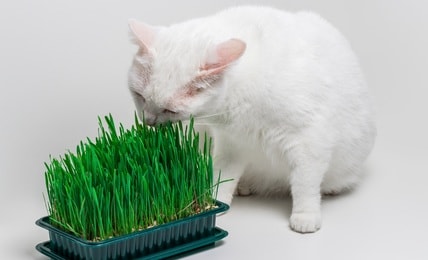
If you’ve done any research into the dietary needs of your cat, you’ve probably learned that she is an obligate carnivore. If you aren’t familiar with the term, it means that your cat needs to eat meats to meet their nutritional requirements. Even with a word like “obligate” in there, your cat may benefit from a little vegetation. In fact, many cats like to munch on plants, so you should consider offering a little bit of cat grass, which can be good for their digestion.
Grass helps a cat’s digestion because:
• It helps them to vomit out anything causing digestion problems
• Adds fiber to their diet to help pooping motility
• Acts as a laxative to relieve constipation
• Is a source of folic acid
• Source of useful vitamins and chlorophyll
• Helps the cat not to eat toxic plants, as they have the grass
The Ways Cat Grass Helps Their Digestion
Vomiting out things that upset them

Cat grass helping digestion is a major reason to give your kitty cat grass. If your cat has consumed something that is upsetting their stomach, they will often rely on consuming grass to trigger themselves to vomit. Your kitty is generally doing this completely on purpose.
Because they do not have enzymes like a cow or a rabbit do to break down large quantities of grass, it makes them vomit. When they vomit, they will also empty their stomach of other things, such as fur or feathers. These components can irritate your cat’s delicate digestive tract and even cause issues like an obstruction.
Relieving constipation
You might be wondering if cat grass is good for constipation. In fact, it is!
Cat grass adds fiber to your kitty’s diet, which can help regulate their gut motility. Broad grasses in particular seem to have an effect almost like that of a laxative, moving material through the gut and helping relieve constipation.
This may be especially helpful in long–haired cats whose digestive tracts are more prone to getting “clogged” by fur. Eating just a little cat grass can help move material along that has gone too far into the gut to be vomited back up and help your cat feel a little more comfortable. It might even save you a trip to the vet for constipation.
Help to relieve an upset stomach
In contrast to broad-leafed grasses that may help relieve occasional constipation, it appears that narrow grasses may be more beneficial at relieving an upset stomach.
A source of folic acid

You might be familiar with some of the grasses grown as a part of cat grass mixtures, such as wheat and barley. These are commonly referred to as cereal grains because of their common usage in human breakfast cereals. These grasses are important because they are a source of folic acid, which is a B vitamin.
In humans and animals, folic acid has a number of vital functions. It is
- Necessary to make red blood cells, which have functions such as carrying oxygen throughout the body.
- Helps repair DNA and RNA, and it has been linked to helping prevent age-related hearing loss, although we aren’t sure how much folic acid prevents that in cats.
- Has also been linked to helping with cell division and growth, as well as enhancing brain health.
As you can see, cat grass has a lot of potential benefits for your kitty.
A source of vitamins and chlorophyll which are good for cats to digest
Another potential reason for cats to eat cat grass is that it may provide other trace minerals. It can also be a source of vitamins, such as A and D.
Cat grass also contains chlorophyll, a pigment that plants use for photosynthesis. Wild cats may have consumed grasses for the healing properties of chlorophyll, as it was once a remedy for pain and infections. As an added benefit, chlorophyll has been linked to being a breath-cleansing agent.
Helps stop your cat from eating other toxic plants

Cat grass has health benefits, but it can also be useful to have a plant that is safe for your kitty to eat. After all, many household plants pose hazards to your cat’s health, including lilies, which cause kidney failure, and philodendrons, which can make your cat’s mouth sore because they have calcium oxalate crystals.
The American pet insurance company Trupanion even recommends having a dedicated kitty plant to keep your cat away from these different toxic plants.
Can Your Cat Eat Cat Grass?
As crazy as it might seem, it’s totally safe for your cat to eat cat grass. The grass seeds have specifically been chosen as plants that are safe for your kitty to munch on. It’s a common misnomer that cats only eat grasses when they are not feeling well. Some experts even recommendallowing your cat to nibble on cat grass. Some researchhas shown that they can eat grass for a variety of reasons.
Eating cat grass allows your cat to partake in a natural behavior that cats in the wild also do. It can provide your indoor kitty with a little taste of the outdoors. If you have a kitty that explores the outdoors, having cat grass inside or on the catio allows them to forage for these greens safely.
What Is Cat Grass?

If you’re like many cat owners, you’re probably wondering what cat grass is. Is it a specific type of grass, or will any grass do?
Cat grass is generally a blend of grass seeds that are grown and can include wheat, barley, rye, and oats. It is grown indoors so that your cat has the opportunity to munch on it safely. Kits for growing cat grass are available from different retailers, or you can make your own mixture by purchasing safe seeds at the store, such as wheat berry.
It’s important to note that cat grass is not catnip, which is a different type of plant entirely.
Don’t Let Your Cat Eat Grass Outside

You should not let your cat eat grass outside.
Growing cat grass indoors or on a catio is a safer alternative to letting your cat graze on grass in the yard. The biggest worry about outdoor grasses is that they may be treated with different products, such as weed killers, pest control chemicals, or even fertilizer. Your cat should not consume any of those things.
This is especially true if your cat spends time outdoors and may not stay in your yard. After all, you don’t always know what your neighbor is putting on their lawn, and you don’t want to get your cat used to eating it.
Another reason not to let your cat eat outdoor grasses is that they can be infested with parasites, such as roundworm or hookworm eggs, that your cat can get. These intestinal parasites are also transmittable to humans, making them a real problem.
When to Worry About Cat Grass
While groups such as Trupanion and Hill’s pet food recommend offering your cat their own plant by giving them cat grass, you want to be careful that you don’t confuse your kitty. Having plants that they can eat and ones that they cannot eat in the house can be a problem.
One way to get around this is by having cat grass down low for your kitty, while keeping plants that they should not eat put up higher, such as on a shelf, so that your kitty can’t eat them. Having the cat grass down low, especially near their food dish or an area they like to lay down at can help make the link that the grass is a special treat for them.
Cats will often regulate the amount of grass they eat to limit it upsetting their stomach. If you notice that your cat is eating large amounts of grass or is consuming it with increasing regularity, it is probably time for your cat to see her veterinarian. Chronic gastrointestinal problems can occur in cats, and they may be consuming cat grass due to issues with digestion.
Growing Cat Grass

You can sow the seeds indoors at any time.
- Sow your cat grass seeds in soil or seed starting plant mix. Sow them 1/4 inch deep.
- Keep the soil moist before the seeds sprout. The soil should be damp but not soaked.
- As sprouts appear, you should use less water on the cat grass.
- Seedlings typically emerge within 7 to 14 days, although sprouts may occur within three days, depending on the seed mix.
- The cat grass is ready for your kitty about 10 to 14 days after sprouting, usually around four inches high.
- Provide plenty of natural light for the cat grass and mist it lightly with a spray bottle. Do not over-water, which can cause the grass to mold and make your cat sick.
- Your cat can graze directly in the container.
- When the cat grass begins to turn brown or wilt,read this article on our site about what to do next to stop this, or start a new container of cat grass for your cat.
When you grow cat grass, the kit or seed mix will usually have directions and suggestions to grow the plant and care for it for your cat.
In Summary
Cat grass is an excellent plant to provide your cat with. In addition to it being safe for them to eat, it has a variety of health benefits, from cat grass aiding digestion to providing folic acid, which can help your kitty’s red blood cells.
It’s an easy-to-grow plant and should be considered for your cat’s favorite window seat or catio.

Samantha Devine is a practicing veterinarian who works in general practice.
Sources
https://trupanion.com/blog/2018/09/autumn-toxic-fall-plants/
https://www.burpee.com/herbs/cat-grass/cat-grass-13780.html
https://www.hillspet.com/cat-care/nutrition-feeding/cat-grass-safety-and-information
https://www.medicalnewstoday.com/articles/219853.php#importance
https://www.petmd.com/cat/care/evr_ct_how-to-grow-cat-grass